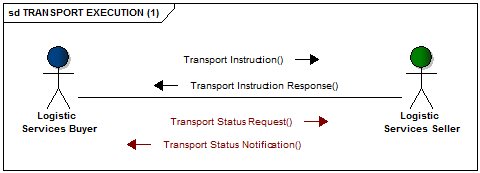Transport planning messages
Transport Capacity Requirements

In the Transport Capacity Requirements message the Logistic Services Buyer will define their transportation capacity requirements by developing a forecast based on aggregated demand covering extended periods of time. (i.e. product/order forecasts are rolled up and extended to shipment forecasts). These requirements should take into consideration seasonality, promotions, production capacities, as well as other factors. As a shipping horizon gets closer, the transport capacity forecasts may become more detailed. The transportation capacity requirement message is sent to the Logistic Services Seller.
Transport Capacity Plan
The Logistic Services Seller is responsible for developing the Transport Capacity Plan. He does this based on the Transport Capacity Requirements communicated to him by the Logistic Services Buyer. The Logistic Services Seller may combine the cargo (for multiple requirement lines) if they are for the same trade lane (i.e. origin/destination), forecast bucket, and service requirement level (e.g. refrigerated vs. general cargo).
Transport Capacity Booking
Transport Capacity Booking is the process to reserve space for estimated consignments or shipments. Typically the booking process covers a period of less than a week prior to actual shipments covered by capacity booking moving through the Logistics Network. The Logistic Services Buyer will send transport capacity booking requests to the Logistic Services Seller.
Capacity booking requests are used to reserve space prior to the goods being ready for despatch. At the point that the goods are actually ready to be moved and have been assigned a shipment or consignment identification, the Transport Execution process begins.
Transport Capacity Response
The Transport Capacity Booking Response is sent by the Logistic Services Seller to the Logistic Services Buyer, accepting or rejecting the Transport Capacity Booking. (Also see Transport Capacity Booking).
Transport execution messages
Transport Instruction

The main objective of the Transport Instruction is to communicate the arrangements (through the agreed conditions) of the movement of the goods (including collection and delivery) between all parties involved and providing the information necessary to perform the handling of the goods.
The Transport Instruction will be sent by the Logistic Services Buyer (supplier, retailer, 3rd party warehouse or freight forwarder) to a Logistic Services Seller (freight forwarder or carrier) upon order creation.
The Transport Instruction can include a request for either executing a consignment or executing a shipment. The trading partners need the ability to differentiate between less detailed transport instructions (shipments) and more detailed instructions (consignments).
Transport Instruction Response
A Transport Instruction Response may be sent from Logistic Services Seller to Logistic Services Buyer in order to confirm the instruction and to provide further detail. Exchanging this message is optional. In many cases there exist standing agreements that the Logistic Services Seller will accept all Transport Instructions from the Logistic Services Buyer ‘as sent’.
Transport Status Request
Message requesting information on the transport status and movements of a transport related object. (see also Transport Status Notification ).
Transport Status Notification
This scenario allows for the exchange of information regarding the status of transport execution progress at any point (in time or place) within the full transport chain.
A status message may be sent:
- as the result of a request or requests for information (through the Transport Status Request message) regarding a consignment or consignments;
- on a scheduled basis at predetermined times;
- on the occurrence of a selected event or events;
- on the occurrence of an exceptional event as agreed by the partners involved.
Transport Pick-up / Drop-off Request

This business message enables the request for an appointment to collect goods at a pick-up location or to deliver goods at a drop-off location.
Initial information about the collection and delivery of goods may already have been exchanged in the transport instruction. However, the party where the goods are collected (consignor / pick-up location /shipper / ship-from location) or delivered (consignee / drop-off location / receiver / ship-to location) will not in all cases be aware of the transport instruction details or they might have changed.
In the pick-up / drop-off request the carrier can specify delays or other relevant status information that might impact the time of collection or the time of delivery.
Transport Pick-up / Drop-off Confirmation
This business message enables the confirmation for an appointment to collect goods at a pick-up location or to deliver goods at a drop-off location.
In the pick-up / drop-off confirmation besides the detailed time and location (dock door) additional handling instructions might be included.






